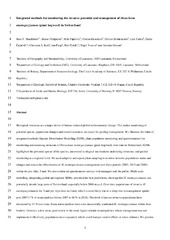Integrated Methods for Monitoring the Invasive Potential and Management of Heracleum mantegazzianum (giant hogweed) in Switzerland
Permanent link
https://hdl.handle.net/10037/22473Date
2020-03-23Type
Journal articleTidsskriftartikkel
Peer reviewed
Author
Shackleton, Ross T.; Petitpierre, Blaise; Pajkovic, Mila; Dessimoz, Florian; Brönnimann, Olivier; Cattin, Loïc; Čejková, Šárka; Pergl, Jan; Pyšek, Petr; Yoccoz, Nigel; Guisan, AntoineAbstract
Biological invasions are a major driver of human-induced global environmental change. This makes monitoring of potential spread, population changes and control measures necessary for guiding management. We illustrate the value of integrated methods (species distribution modelling (SDM), plant population monitoring and questionnaires) for monitoring and assessing invasions of Heracleum mantegazzianum (giant hogweed) over time in Switzerland. SDMs highlighted the potential spread of the species, uncovered ecological mechanisms underlying invasions and guided monitoring at a regional level. We used adaptive and repeat plant sampling to monitor invasive population status and changes, and assess the effectiveness of H. mantegazzianum management over three periods (2005, 2013 and 2018) within the pre-Alps, Vaud. We also conducted questionnaire surveys with managers and the public. Multiscale modelling, and integrating global and regional SDMs, provided the best predictions, showing that H. mantegazzianum can potentially invade large parts of Switzerland, especially below 2 000 m a.s.l. Over time, populations of invasive H. mantegazzianum in the Vaud pre-Alps have declined, which is most likely due to a sharp rise in management uptake post 2007 (7% of municipalities before 2007 to 86% in 2018). The level of known invasive populations has decreased by 54% over time. Some municipalities have even successfully eradicated H. mantegazzianum within their borders. However, a few areas, particularly in the rural, higher-altitude municipalities, where management was not implemented effectively, populations have expanded, which could hamper control efforts at lower altitudes. We provide encouraging evidence that control measures can be effective in reducing plant invasions with long-term commitment, as well as a good template for using integrated methodological approaches to better study and monitor invasive alien species.
Publisher
Springer LinkCitation
Shackleton, Petitpierre, Pajkovic, Dessimoz, Brönnimann, Cattin, Čejková, Kull, Pergl, Pyšek, Yoccoz, Guisan. Integrated Methods for Monitoring the Invasive Potential and Management of Heracleum mantegazzianum (giant hogweed) in Switzerland. Environmental Management. 2020;65(6):829-842Metadata
Show full item recordCollections
© Springer Science+Business Media, LLC, part of Springer Nature 2020


 English
English norsk
norsk